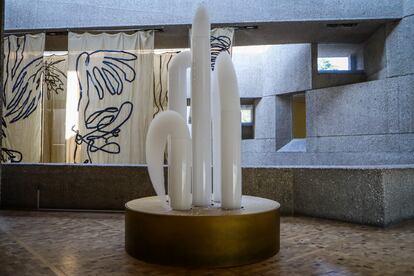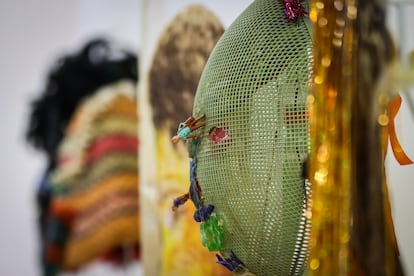David Medalla tried to promote a change in art from the margins. Born in the Philippines in 1938, the artist migrated to London, where he did not achieve recognition in the artistic environment of the British capital, but from where he founded the bases of a movement committed to social changes. Medalla used his art to denounce the excesses of the kleptocrat Ferdinand Marcos, support the cause of Salvador Allende in Chile or open spaces for misunderstood artists in the very elitist world of contemporary art. The Tamayo Museum in Mexico City, in collaboration with the Hammer Museum in Los Angeles, receives the work of the marginal artist whose work encompasses the performative and collaborative art movements to confront the rigid rules of what he defined as “institutional” creation. ”.
Despite living in London, the pinnacle of artistic movements in Europe, the British saw him as a minor creator, far removed from the aesthetic canon that opened the doors of museums and galleries. Medal was part of the movement known as Land Artor the art of creating from nature, using landscapes or their resources, and marked a style that according to Ana Sampietro Brosa, exhibition coordinator at Tamayo and curatorial assistant of the exhibition, represented a break in the art world. “He was a little-known artist, in Mexico he is almost not known, but in the history of art he has been very influential. He worked a lot in groups, he promoted non-institutional works, because he considered himself a non-institutional artist,” explains the expert.
The Tamayo exhibition, which will be open until March, is based on an exhaustive study of Medalla’s work. The exhibition curated by Aram Moshayedi brings together a five-year research work on the Filipino author, his production and his political commitment. Medalla was homosexual and part of his work explores male sexuality. The piece that opens the exhibition, titled Cloud Canyonsshows a series of tubes through which foam emerges. “It is a sculpture that has soap and glycerin and what it does is remove this foam as if from between canyons of clouds, which refer to sexuality, because it can also be seen as semen. Many of Medalla’s pieces have certain nods to the sensual,” explains Sampietro Brosa. There are drawings of male nudes in the exhibition or the image that illustrates the exhibition: a swimsuit worn by his partner, Adam Nankervis, while he has an erection. “It’s like a mockery,” says the curator, but also a gesture to Pieter Mondrian and his abstract art, the use of lines, of which Medalla was a great admirer. In fact, the 1993 work is titled Mondrian in the High.
The sample, which is called In conversation with the cosmos, It also takes a look at the politically committed work of the Filipino author. Medalla openly opposed the Marcos dictatorship, which devastated the Philippines from 1965 to 1986, and organized protests to denounce the dictator’s abuses. The exhibition shows the banners created by the artist, who gathered newspaper publications with news about attacks on freedoms. Medalla also supported the Chilean government of Salvador Allende, which was overthrown in 1972 by a coup d’état. In that country he collaborated with Cecilia Vicuña, one of the great Latin American artists who, like him, did not achieve recognition until old age. In fact, she went so far as to say: “I thought I was going to die as a secret artist.” From that experience in Chile you can see several works, among them that of a woman in a demonstration with a red star above her head and the quote “socialist art through socialist revolution.” “He was an artist who was always wanting social change from the left,” says Sampietro Brosa.
He was also a non-conformist. Medalla was uncomfortable with how elitist the art world could be, so he decided to work for many years with groups of misunderstood or marginalized artists, like him. He founded the Signals gallery in London in 1964 as a space for open experimental art. “It gave marginal artists a place within the British art scene,” says Sampietro Brosa. “He lived almost his entire life in London, but he was never given nationality nor was he considered a British artist. In the research that the curator did, he found that the first piece that an English collection acquired was only in 2013. When he returned to the Philippines, they did not consider him a Filipino artist either. He was, then, an anti-system character, but one who influenced social movements,” explains the expert. “He was an avant-garde artist,” he adds. His position against the institutional was such that when he was invited to a biennial in Johannesburg he was surprised that only artists participated by invitation, which left many creators aside, so he decided to organize his own biennial in London, “in the that anyone who had a proposal, something to say that made sense in this world could participate,” says the curator.

For Medalla, the final result of a work was not the most important thing, as most artists see it, but rather his interest focused on the creation process. I did a lot of prior research before producing a piece or assembly. and many of his works are ephemeral and have a lot of improvisation. He called them impromptu. “Were performances that he did in public squares and that many times had to do with very simple things, sometimes using only posters,” says Sampietro Brosa. Medalla met his partner, 25 years his junior, in New York, where he traveled to study literature. There he rubbed shoulders with art figures such as Marcel Duchamp. Together with Nankervis they founded a new artistic collective, the Mondrian Fan Club, in tribute to the artist who for them revolutionized the history of art. The Filipino suffered a stroke in 2016, which left him paralyzed and bedridden. Despite that, he and his partner continued creating. One part of the exhibition shows images of Medalla in bed, with masks on his face made by his partner. “They are very strong portraits. It is like a wink of love and being able to work together when I was already immobile,” says the Tamayo curator. The artist died at the age of 82, already with recognition, but always challenging the establishment artistic.

